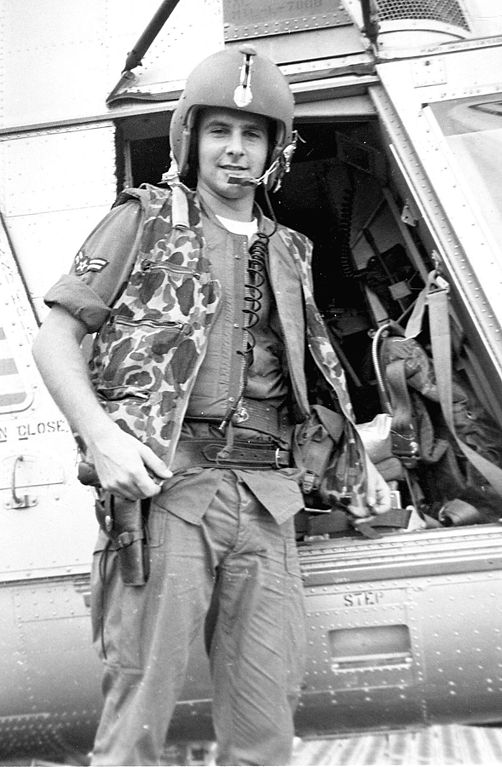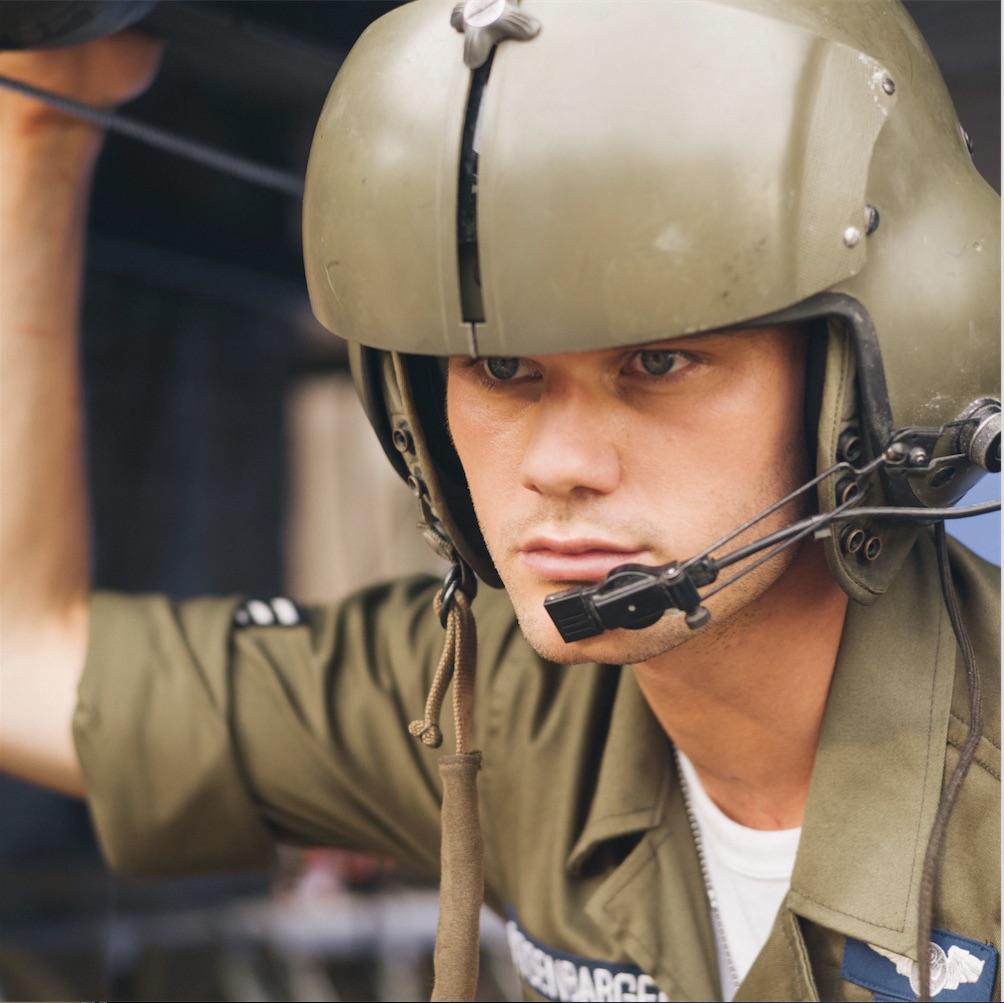


Rank, duty position and unit at time of action:
Airman First Class, Pararescue Jumper, Detachment 6, 38th
Aerospace Rescue and Recovery Squadron, US Air Force
War:
Vietnam War
Place and date of action:
Xa Cam My, Dong Nai Province, Republic of Vietnam (South
Vietnam), 11 April 1966
Portrayed by:

In the film:
*The President of the United States of America, authorized by Act of Congress, March 3, 1963 has awarded in the name of the Congress the Medal of Honor posthumously to:
for conspicuous gallantry and intrepidity in action at the risk of his life above and beyond the call of duty near Cam My, April 11, 1966:
Rank and organization: Airman First Class, U.S. Air Force, Detachment 6, 38th Aerospace Rescue and Recovery Squadron, Bien Hoa Air Base, Republic of Vietnam.
Place and date: Near Cam My, April 11, 1966
Entered service at: Piqua, Ohio
Born: July 8, 1944, Piqua, Ohio
Citation:
A1C William H. "Pits" Pitsenbarger was initially recommended
for a posthumous Medal of Honor based on the accounts of the
surviving members of Charlie Company, 2nd Battalion 16th
Infantry Regiment, 1st Infantry "The Big Red One" Division, and
his crew and squadron mates of the 38th ARRS (who flew Kaman
HH-43 Huskies in real life, for which Bell UH-1 Iroquois, aka
"Hueys", were substituted in the film due to the scarcity of the
former type). The Air Force chain of command downgraded the
award to the Air Force Cross, the second-highest USAF award for
valor, equivalent to the Army Distinguished Service Cross and
the Navy Cross, the rationale from the chain of command stated
as insufficient documentation. (In 1966, Airman First Class was
a 3-stripe rank and Staff Sergeant was 4-stripes, the
next-higher rank, with the rank of "Buck" Sergeant then
nonexistent. He received a posthumous promotion to Staff
Sergeant when the award was finally upgraded.)
After Charlie Company had been ambushed and surrounded by a
much larger Viet Cong force in an area that was not designated a
helicopter Landing Zone and was under enemy fire, Army aviation
medevac helicopters were unable to respond to the call to
evacuate casualties; the Air Force's Detachment 6, 38th ARRS,
trained and equipped to drop penetrator seats and litters on a
cable and winch through jungle canopy to rescue downed aircrews
in hostile territory, responded. After realizing that the
company medic was one of the casualties being evacuated,
Pitsenbarger volunteered to ride the penetrator to the ground
and replace the wounded medic in administering medical aid to
the other casualties still on the ground and place them in the
extraction litter. He was under no military obligation to do so
and this was a clear example of action "above and beyond the
call of duty" which would cost him his life.
[Just five months earlier at the Battle of Ia Drang in the
Vietnam Central Highlands, a similar situation had occurred
regarding the inability of Army dedicated medevac helicopters to
go into what was a hot LZ to pick up casualties. This led Major
Bruce P. Crandall and Captain Ed W. Freeman, the two ranking
officers of the assault helicopter company responsible for
regular transport of the 1st Battalion 7th Cavalry Regiment (the
unit engaged at Ia Drang) and their crews to assume the medevac
duties at the hot LZ, for which the two officers also eventually
received the Medal of Honor.]
This film offers a different perspective from the others in the
Classic Heroism section of this website. The action for which
Pitsenbarger received his posthumous Medal of Honor is seen
through several flashbacks throughout the length of the film
from the perspectives of several members of Charlie Company and
from those of the other members of his rescue helicopter crew.
The focus of the film was much less on Pitsenbarger's heroism
than on the struggle of his crew mates, and the men whose lives
he saved, to have his case reviewed and the award upgraded to
the originally recommended MoH over thirty years after the fact,
spurred on by the fact that his father Frank Pitsenbarger
(played by Christopher Plummer) is terminally ill and wants to
live to see the award upgraded. The focus is such that actor
Jeremy Irvine's name appeared in the opening credits after that
of at least a half-dozen members (the authors weren't keeping an
exact count) of the "all star cast" (at least of actors who were
popular in movies and TV series of a decade or more ago).
Furthermore, as a disclaimer in the end credits points out, with
the exception of William Pitsenbarger and his parents (his
mother Alice was played by Diane Ladd), all the characters in
the film were fictionalized "for the purposes of dramatization".
This opened the floodgates for fabrication and
misrepresentation under the guise of dramatic license. History
vs Hollywood, a like-minded and similarly structured
website to ours with a more generalized scope on fact-based
movies of all genres, points out that the real-life driving
force for the review of Pitsenbarger's case and upgrade of the
award was a young historian named Parker Hayes. In the late
1990s, Hayes was employed by the Air Force Sergeants Association
as the curator of the (now defunct) Airmen Memorial Museum in
Suitland, Maryland. He published a biography of Pitsenbarger on
the museum website and quickly found himself receiving several
emails from, and becoming the point of contact for, several
veterans of Charlie Company 2/16th Infantry and the 38th ARRS
seeking his help in getting Pitsenbarger's award reviewed. Hayes
picked up the ball by interviewing several of the veterans,
during which he formed a bond with them, and compiling their
statements onto the proper Department of Defense form to request
the review.
For the film, Hayes was replaced by a fictional civilian lawyer
(played by Sebastian Stan) at the Office of the Secretary of the
Air Force, who becomes the central character of the film and who
reluctantly and evasively takes on the request from another
Pararescue Jumper, now retired, (played by William Hurt) from
Pitsenbarger's helicopter crew on behalf of his parents. All of
this takes place on the heels of the Secretary (played by Linus
Roache) announcing his resignation and both the Secretary and
the lawyer's immediate supervisor (played by Bradley Whitford)
pressuring him to brush the case aside and pay more attention to
the transition to a new Secretary and resulting changes in their
assignments, all during a presidential election year. As
Sebastian Stan's character interviews Frank and Alice
Pitsenbarger and the veterans who witnessed the actions, he
gains more sympathy for them while encountering increasing
obstacles put up by the military bureaucracy. The History vs
Hollywood website characterizes these obstacles as
Conspiracy Theories, including a coverup of a Friendly Fire
incident during the battle; interservice rivalry because
Pitsenbarger and the Air Force made the Army look bad during the
operation; and a higher-ranking officer in the Big Red One
Division at the time, now a United States Senator (played by
Dale Dye), failing to do a quid pro quo for another
senator who then on the Senate floor blocks his efforts to
advance the review of the case; this culminates in the lawyer
going public with all the obstruction.
None of which, except for the Friendly Fire incident, matches anything in the historical record; no Secretary of the Air Force has ever resigned during a presidential election year since the office was created by the National Security Act of 1947 which separated the Air Force from the Army. Over the course of this drama, Pitsenbarger's heroism fades into the background and the film becomes about military bureaucracy, while the characterization of the veterans straddles the line between bringing due attention to the plight of combat veterans suffering from post-traumatic stress, and perpetuating the Hollywood stereotype of the emotionally scarred, dysfunctional Vietnam veteran.
The film is evasively vague over the timeline of the narrative
and the review and upgrade of Pitsenbarger's award, starting
with Pitsenbarger's action being "thirty years ago" and it being
an election year (therefore presumably 1996), to the action
being "over thirty years ago" and then "thirty two years ago"
while still being an election year, to Sans's character going
public with the obstruction while still being an election year,
to Frank and Alice Pitsenbarger receiving their son's Medal of
Honor on December 8, 2000 (the actual real-life date of the
presentation), a few days before the result of that year's
unusually protracted presidential election was settled by a US
Supreme Court decision. Frank Pitsenbarger lived for exactly 14
more months after receiving the award.
In actuality, Parker Hayes had quietly submitted the award
review packet to the Department of the Air Force sometime in
1999; the review and upgrade over the course of between one and
two years was rather remarkably expedited, compared to many
other cases of many other reviews of previously
rejected/downgraded Medal of Honor nominations several decades
after the fact, to include Major Crandall and Captain Freeman
mentioned above.
The authors actually gave serious consideration to placing this
film in the Notable Fiction
category, under the same criteria as the cameo insertion of the
Medal of Honor actions of World War II B-29 Superfortress bomber
crewman Staff Sergeant Henry E. Erwin, in the otherwise totally
fictional 1951 film The Wild Blue Yonder. We gave even
more consideration to placing it in the Hollywood Abominations
category because of the factual distortions. This film, however,
did accurately depict A1C Pitsenbarger's Medal of Honor earning
actions in short segments over the length of the film, although
we wish that more time had been spent in giving his character
and his background much more depth. The authors have a combined
total of over half a century of service as commissioned officers
in the Armed Forces of the United States, and government
bureaucracy is difficult enough in real life without having to
be fictionally fabricated and exaggerated as this film did. We
decided to be generous in leaving it in the Classic Heroism
category to honor William Hart Pitsenbarger but not the film
itself.